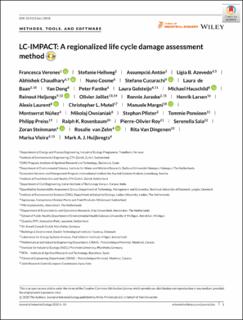| dc.contributor.author | Verones, Francesca | |
| dc.contributor.author | Hellweg, Stefanie | |
| dc.contributor.author | Anton, Assumpcio | |
| dc.contributor.author | Azevedo, Ligia B | |
| dc.contributor.author | Chaudhary, Abhishek | |
| dc.contributor.author | Cosme, Nuno | |
| dc.contributor.author | Cucurachi, Stefano | |
| dc.contributor.author | de Baan, Laura | |
| dc.contributor.author | Dong, Yang | |
| dc.contributor.author | Fantke, Peter | |
| dc.contributor.author | Golsteijn, Laura | |
| dc.contributor.author | Hauschild, Michael | |
| dc.contributor.author | Heijungs, Reinout | |
| dc.contributor.author | Jolliet, Olivier | |
| dc.contributor.author | Juraske, Ronnie | |
| dc.contributor.author | Larsen, Henrik | |
| dc.contributor.author | Laurent, Alexis | |
| dc.contributor.author | Mutel, Christopher | |
| dc.contributor.author | Margni, Manuele | |
| dc.contributor.author | Núñez, Montse | |
| dc.contributor.author | Owsianiak, Mikolaj | |
| dc.contributor.author | Pfister, Stephan | |
| dc.contributor.author | Ponsioen, Tommie | |
| dc.contributor.author | Preiss, Phillip | |
| dc.contributor.author | Rosenbaum, Ralf | |
| dc.contributor.author | Roy, Pierre-Olivier | |
| dc.contributor.author | Sala, Serenella | |
| dc.contributor.author | Steinmann, Zoran J.N. | |
| dc.contributor.author | Van Zelm, Rosalie | |
| dc.contributor.author | Van Dingenen, Rita | |
| dc.contributor.author | Vieira, Marisa | |
| dc.contributor.author | Huijbregts, Mark | |
| dc.date.accessioned | 2020-09-01T08:37:35Z | |
| dc.date.available | 2020-09-01T08:37:35Z | |
| dc.date.created | 2020-06-03T10:01:52Z | |
| dc.date.issued | 2020 | |
| dc.identifier.issn | 1088-1980 | |
| dc.identifier.uri | https://hdl.handle.net/11250/2675763 | |
| dc.description.abstract | Life cycle impact assessment (LCIA) is a lively field of research, and data and models are continuously improved in terms of impact pathways covered, reliability, and spatial detail. However, many
of these advancements are scattered throughout the scientific literature, making it difficult for
practitioners to apply the new models. Here, we present the LC-IMPACT method that provides
characterization factors at the damage level for 11 impact categories related to three areas of protection (human health, ecosystem quality, natural resources). Human health damage is quantified
as disability adjusted life years, damage to ecosystem quality as global species extinction equivalents (based on potentially disappeared fraction of species), and damage to mineral resources as
kilogram of extra ore extracted. Seven of the impact categories include spatial differentiation at
various levels of spatial scale. The influence of value choices related to the time horizon and the
level of scientific evidence of the impacts considered is quantified with four distinct sets of characterization factors. We demonstrate the applicability of the proposed method with an illustrative
life cycle assessment example of different fuel options in Europe (petrol or biofuel). Differences
between generic and regionalized impacts vary up to two orders of magnitude for some of the
selected impact categories, highlighting the importance of spatial detail in LCIA. This article met
the requirements for a gold – gold JIE data openness badge described at http://jie.click/badges. | en_US |
| dc.language.iso | eng | en_US |
| dc.publisher | Wiley | en_US |
| dc.rights | Navngivelse 4.0 Internasjonal | * |
| dc.rights.uri | http://creativecommons.org/licenses/by/4.0/deed.no | * |
| dc.title | LC-IMPACT: A regionalized life cycle damage assessment method | en_US |
| dc.type | Peer reviewed | en_US |
| dc.type | Journal article | en_US |
| dc.description.version | publishedVersion | en_US |
| dc.source.journal | Journal of Industrial Ecology | en_US |
| dc.identifier.doi | 10.1111/jiec.13018 | |
| dc.identifier.cristin | 1813579 | |
| dc.description.localcode | This is an open access article under the terms of the Creative Commons Attribution License, which permits use, distribution and reproduction in any medium, provided the original work is properly cited. c 2020 The Authors. Journal of Industrial Ecology published by Wiley Periodicals LLC on behalf of Yale University | en_US |
| cristin.ispublished | true | |
| cristin.fulltext | original | |
| cristin.qualitycode | 2 | |

